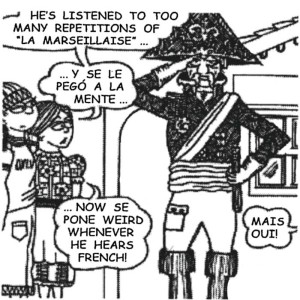Pegar and Pegársele
 I never have understood the appeal of the Smurfs. I once supposed their dialogue was a preschool guessing game. “OK, Joey, what does the third word in ‘The smurfs smurfed all the smurfs to the smurf’ mean?”
I never have understood the appeal of the Smurfs. I once supposed their dialogue was a preschool guessing game. “OK, Joey, what does the third word in ‘The smurfs smurfed all the smurfs to the smurf’ mean?”
The smurfiest Spanish verb may be pegar. A classical root is missing, and only Portuguese and Catalonian have even semi-cognates for it. So I suspect that it appeared after Rome’s fall, maybe Visigoth raiders smurfed it into local Iberian languages as a pidgin catchall?
Pegar translates about every fifth English verb. Meanings include (but are not limited to): sticking, gluing, clinging, matching/harmonizing, hitting, inflicting, acquiring, experiencing, taking effect, giving, punishing, transmitting and infecting. If I had to reduce all this to a single commonality, maybe it would be affixing.
Now I try not to overuse pegar or any other all-purpose verb. Better just to know that I will hear it, and that it can mean whatnot; that way I am alert to confusions. But I also study its synonyms, so that my reply to, for instance, “¡Me pegaste el mononucleosis!” can be a clarifying, “¿Yo te contagié el mono?”
Admittedly, there are times when only pegar is called for, as in pasting text; your computer’s pegar command means paste, and stamps se pegan to envelopes. So pasting and gluing are, overall, the most reliable equivalents. But for both kinds of sticking —adhering and stabbing—I prefer adherer and apuñalar in my clarifying replies. Perhaps because the former requires a stem change (e to ie), the Visigoth raiders, who did not know conjugation from constipation, started substituting pego for adhiero when they had to say “I stick Smurf decals on my shield.”
This kind of sticking has transitive and passive-voice (“se-le”) forms. Transitive, as in Los visigotas pegan (adhieren) las calcomanías de los Smurfs a sus escudos, and se-le style as in Mi fama como columnista bobo se me pega (se me adhiere)a mí (my reputation as a hack columnist clings to me). The infinitives of the latter type, in case you are led to conjugate, I mean constipate, them, are pegársele and adherírsele. When I travel with my sons, they tell me, “Dad, te nos pegamos.” But te nos enganchamos has more precision.
Another pegar caboodle relates to violence, real or implied. In this case, something harmful is affixed with an anatomical instrument (boot, fist, dirty look, etc.). If a blow, then you can just, uh, stick with the verb: mi reina me pega (my queen beats me), although golpear (to bruise/pound) is more precise (ella me golpea).
In the interest of specificity, you need a noun to describe what has been affixed on you; it can be the action described or its consequence. Hence, “They gave him a (1) a kick (2) a knock on the head (3) a bruise (4) a shot in the foot (5) a lash (6) an injection”—would be Le pegaron a él (1) una patada (2) un golpe en la cabeza (3) una contusion (4) un tiro en la pie (5) un latigazo (6) una inyección. But again, to avoid overusing pegar, I choose finite verbs like azotar (to lash, scourge) and inyectar. Zennily, pegar works not just for injections but for pills when they take effect: la aspirina me pega.
Then there is pegársele (touched on above), which is really just pegarse, meaning “is affixed” with an added indirect object (le, the target of the affixing). Things that can be smurfily pegados using pegársele include accents (se te pegó su acento), manners (se me pegaron sus hábitos malos), and the flus (se nos pegó la gripe).
Now let us attend to matching and suiting. Traditional ways to express them are hacer juego (for clothes or drapes) and convenirle (for people or situations). So, where we once had la bolsa no hace juego con los zapatos, we can now say la bolsa no se pega con los zapatos. Instead of trabajar como payaso no le convenía (working as a clown did not suit him/her), we can now say trabajar como payaso no se le pegaba. Even here, affixing is alluded to, in that only certain things should ever be affixed—things that match or suit.
There is more to pegar and pegarse. Happily, the associated adjective and noun are unzenny. Pegamento is always glue or paste. Pegado means stuck together or adjacent, as in mi casa está pegada con la suya (my house is next door to hers/his/theirs/y’alls). This is sensible, given that mortar is masonry “glue.” But stuck indicating closeness/intimacy is unido. And sticky is mieloso (“honey-y”)—or pegajoso.
OK, reader. How much of all this se te pega? Will it “stick” with you?
Sixty Zen columns now form a book, The Zen of Pues, useful to Spanish scholars at all levels. Visit www.iqbooks.com; also available in bookstores in La Antigua Guatemala and Panajachel, Lake Atitlán.
You can contact Dwight Wayne Coop directly at maddogwriter@yahoo.com.sg